|
Central banks worldwide cut interest rates over the past two weeks. Where in the past, banks usually cut rates by 25 basis points — or 50 basis points if there was trouble — now cuts of 100 basis points and more are the norm given the extraordinary circumstances that currently exist in the financial markets. Continued cuts of that size are unlikely for most central banks going forward, given their current relatively low rate levels. Few banks want to embrace ZIRP — zero interest rate policy. The Bank of Japan had real experience with ZIRP in the not too distant past. It provoked its governor, Masaaki Shirakawa, to express concern over the impact of further monetary loosening on the short term money market. He said, "In terms of ensuring smooth functioning of the short-term money market, the central bank must pay attention to whether (more rate cuts) cause various market problems under current accommodative conditions."
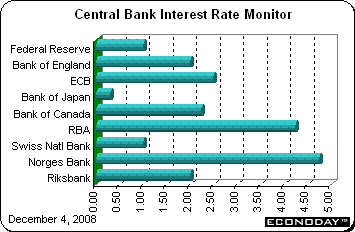 Among the banks that lowered rates were the People’s Bank of China (108 basis points), Reserve Bank of Australia (100 basis points), Reserve Bank of New Zealand (150 basis points), Bank of England (100 basis points), Bank of Indonesia (25 basis points), Bank of Thailand (100 basis points), Sweden’s Riksbank (175 basis points) and the European Central Bank (75 basis points). Although the Bank of Japan held an ‘extraordinary’ — that is unscheduled — meeting, they left interest rates unchanged at 0.3 percent. Among the banks that lowered rates were the People’s Bank of China (108 basis points), Reserve Bank of Australia (100 basis points), Reserve Bank of New Zealand (150 basis points), Bank of England (100 basis points), Bank of Indonesia (25 basis points), Bank of Thailand (100 basis points), Sweden’s Riksbank (175 basis points) and the European Central Bank (75 basis points). Although the Bank of Japan held an ‘extraordinary’ — that is unscheduled — meeting, they left interest rates unchanged at 0.3 percent.
As if we didn’t know it, the NBER, the official arbiter of U.S. recession dating, officially declared that the recession began in January 2008, making it almost a year old and already longer than the 2001 and 1990-91 recessions. And in Europe, GDP contracted for two consecutive quarters putting them in a technical recession. Economic data continues to be dreadful as new multi-year lows are plumbed.
For the record — were it not for gains by most indexes in the last week of the month, November’s losses would have been much greater. Stocks held up despite continued poor economic data which offered confirmation that most of the major countries are in recession. Sentiment indexes in Europe, the UK, the U.S. and Japan touched new lows while price indexes continued to show dramatic declines in price pressures thanks primarily to plummeting commodity prices. And in Japan, industrial production — thanks to sinking exports — plunged and consumer spending declined. Data from the U.S. were bleak and the Federal Reserve Beige Book illustrated anecdotally the breadth of the U.S. downturn.
After ending November with healthy gains, the indexes retreated once again at the start of December. Rather than cheering investors, the massive interest rate cuts initiated globally by central banks sent investors scurrying to bonds as they pondered the length and depth of the current worldwide recession. On the week, only the Shanghai Composite posted a gain.
|
|
2007 |
2008 |
% Change |
|
Index |
Dec 31 |
Nov 28 |
Dec 5 |
Week |
Nov |
Year |
| Asia |
|
|
|
|
|
|
|
| Australia |
All Ordinaries |
6421.0 |
3672.70 |
3427.20 |
-6.7% |
-7.8% |
-46.6% |
| Japan |
Nikkei 225 |
15307.8 |
8512.27 |
7917.51 |
-7.0% |
-0.8% |
-48.3% |
|
Topix |
1475.7 |
834.82 |
786.02 |
-5.8% |
-3.7% |
-46.7% |
| Hong Kong |
Hang Seng |
27812.7 |
13888.24 |
13846.09 |
-0.3% |
-0.6% |
-50.2% |
| S. Korea |
Kospi |
1897.1 |
1076.07 |
1028.13 |
-4.5% |
-3.3% |
-45.8% |
| Singapore |
STI |
3482.3 |
1732.57 |
1659.17 |
-4.2% |
-3.4% |
-52.4% |
| China |
Shanghai Composite |
5261.6 |
1871.16 |
2018.66 |
7.9% |
8.2% |
-61.6% |
|
|
|
|
|
|
|
|
| India |
Sensex 30 |
20287.0 |
9092.72 |
8965.20 |
-1.4% |
-7.1% |
-55.8% |
| Indonesia |
Jakarta Composite |
2745.8 |
1241.54 |
1202.34 |
-3.2% |
-1.2% |
-56.2% |
| Malaysia |
KLSE Composite |
1445.0 |
866.14 |
838.28 |
-3.2% |
0.3% |
-42.0% |
| Philippines |
PSEi |
3621.6 |
1971.57 |
1888.96 |
-4.2% |
1.0% |
-47.8% |
| Taiwan |
Taiex |
8506.3 |
4460.49 |
4225.07 |
-5.3% |
-8.4% |
-50.3% |
| Thailand |
SET |
858.1 |
401.89 |
392.87 |
-2.2% |
-3.5% |
-54.2% |
|
|
|
|
|
|
|
|
| Europe |
|
|
|
|
|
|
|
| UK |
FTSE 100 |
6456.9 |
4288.01 |
4049.37 |
-5.6% |
-2.0% |
-37.3% |
| France |
CAC |
5614.1 |
3262.68 |
2988.01 |
-8.4% |
-6.4% |
-46.8% |
| Germany |
XETRA DAX |
8067.3 |
4669.44 |
4381.47 |
-6.2% |
-6.4% |
-45.7% |
|
|
|
|
|
|
|
|
| North America |
|
|
|
|
|
|
|
| United States |
Dow |
13264.8 |
8829.04 |
8635.4 |
-2.2% |
-5.3% |
-34.9% |
|
NASDAQ |
2652.3 |
1535.57 |
1509.3 |
-1.7% |
-10.8% |
-43.1% |
|
S&P 500 |
1468.4 |
896.24 |
876.1 |
-2.3% |
-7.5% |
-40.3% |
| Canada |
S&P/TSX Comp. |
13833.1 |
9270.62 |
8117.0 |
-12.4% |
-5.0% |
-41.3% |
| Mexico |
Bolsa |
29536.8 |
20534.720 |
20081.8 |
-2.2% |
0.4% |
-32.0% |
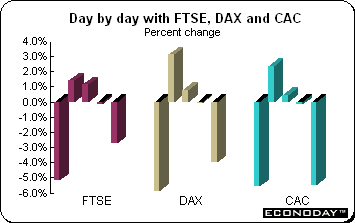 While the gains in the last week of November were impressive for the three indexes followed here, they were quickly eroded in the first week of December. And on Thursday, European and UK stocks first rallied on the expectation of sizeable interest rate cuts by the Bank of England and the European Central Bank, then moved down after the cuts were announced. And economic data continue to show across the board declines in everything from retail sales and GDP to the purchasing managers’ indexes for manufacturing and services. While the gains in the last week of November were impressive for the three indexes followed here, they were quickly eroded in the first week of December. And on Thursday, European and UK stocks first rallied on the expectation of sizeable interest rate cuts by the Bank of England and the European Central Bank, then moved down after the cuts were announced. And economic data continue to show across the board declines in everything from retail sales and GDP to the purchasing managers’ indexes for manufacturing and services.
Stocks plunged on Monday thanks to the universally record low readings of the purchasing managers’ manufacturing indexes and the NBER announcement that the U.S. has been in recession for all of 2008. Although the indexes rebounded on Tuesday and Wednesday, they did not recover Monday’s losses. The markets were down Thursday as the sizable interest rate cuts by the European Central Bank and the Bank of England were overshadowed by ECB president Jean Claude Trichet's forecast that the EMU would contract in 2009. He said the EMU would shrink about 0.5 percent in 2009 — it was the first time that the ECB has ever predicted a recession. And on Friday, the losses continued thanks to the combined effect of the awful employment report and lower index readings in the U.S. On the week, the indexes were down as miners and oil stocks tumbled after the U.S. employment data proved much worse than expected, provoking concerns about global demand.
Bank of England
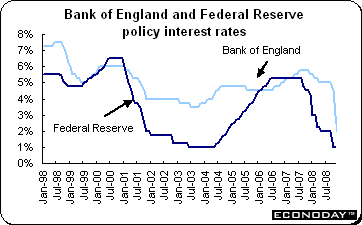 The Bank of England cut its key interest rate by 100 basis points to 2.0 percent as expected though many in the markets were looking for even more. This cut follows the Bank’s surprise 150 basis point cut in November. Since September, the Bank has reduced rates by 3 full percentage points. This puts interest rates at the lowest level since 1951 and equals its lowest rate since the Bank was founded in 1694. It would also mark the steepest ever drop in rates. The last time the Bank of England cut interest rates by 1 percentage point to 2 percent was October 26 1939. The Bank of England cut its key interest rate by 100 basis points to 2.0 percent as expected though many in the markets were looking for even more. This cut follows the Bank’s surprise 150 basis point cut in November. Since September, the Bank has reduced rates by 3 full percentage points. This puts interest rates at the lowest level since 1951 and equals its lowest rate since the Bank was founded in 1694. It would also mark the steepest ever drop in rates. The last time the Bank of England cut interest rates by 1 percentage point to 2 percent was October 26 1939.
Dreadful economic data seems to be the rule with both the manufacturing and service PMIs lows. And GDP declined 0.5 percent in the third quarter with weakness pervasive throughout the major categories. Consumer spending fell 0.2 percent in the quarter after a 0.1 percent drop in the period before, while investment spending fell 2.4 percent, dragged down by a slump in house building. And housing prices continue to drop.
European Central Bank
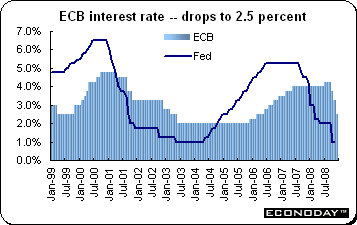 The ECB lowered its key interest rate by 75 basis points to 2.5 percent today. Analysts were expecting a 50 basis point cut but were hoping for more. The move was the largest that the Bank has made in its almost 10-year existence. Economic news continues to be dire and points to a deep recession. GDP has declined in the last two quarters and data such as the purchasing managers’ indexes showed both manufacturing and service sector output contracting. The ECB lowered its key interest rate by 50 basis points to 3.25 percent in November after lowering rates on October 8 by 50 basis points in concert with the Federal Reserve, Banks of England and Canada and other international central banks. The October rate cut was the first by the ECB in five years. The ECB lowered its key interest rate by 75 basis points to 2.5 percent today. Analysts were expecting a 50 basis point cut but were hoping for more. The move was the largest that the Bank has made in its almost 10-year existence. Economic news continues to be dire and points to a deep recession. GDP has declined in the last two quarters and data such as the purchasing managers’ indexes showed both manufacturing and service sector output contracting. The ECB lowered its key interest rate by 50 basis points to 3.25 percent in November after lowering rates on October 8 by 50 basis points in concert with the Federal Reserve, Banks of England and Canada and other international central banks. The October rate cut was the first by the ECB in five years.
In his post-meeting press conference, ECB president Jean Claude Trichet said the eurozone economy would shrink in 2009 for the first time since 1993. Trichet declined to give clues on further moves, saying only that the ECB shouldn’t get “trapped” by cutting rates too low. The ECB predicted that GDP would shrink around 0.5 percent and inflation would ease to about 1.4 percent in 2009. Trichet said the decision to cut rates was made by consensus and declined to divulge if there were calls for smaller or bigger cuts. He noted the bank had already cut rates at the fastest pace in its history and offered unlimited cash to the region’s banks.
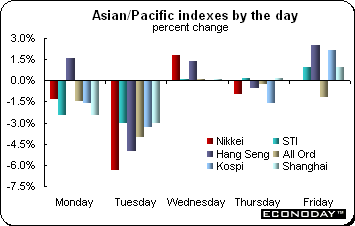 Most Asian/Pacific stock indexes reversed course last week, giving back most or all of the previous week’s advances. This was despite the numerous interest rate cuts that peppered the region. The lone exception was the Shanghai Composite — it was up last week, gaining 7.9 percent after losing 5 percent during the last week in November thanks to the People’s Bank of China’s massive interest rate cut effective on November 27. Investors hope that a meeting of top economic planners early next week will produce more government economic stimulus in addition to the package announced on November 9. Most Asian/Pacific stock indexes reversed course last week, giving back most or all of the previous week’s advances. This was despite the numerous interest rate cuts that peppered the region. The lone exception was the Shanghai Composite — it was up last week, gaining 7.9 percent after losing 5 percent during the last week in November thanks to the People’s Bank of China’s massive interest rate cut effective on November 27. Investors hope that a meeting of top economic planners early next week will produce more government economic stimulus in addition to the package announced on November 9.
On Friday, stocks were mixed as investors awaited the U.S. employment situation report. The data were released after markets here had closed. The large European and British interest rate cuts had little impact given this heavily export oriented area’s concerns about recessions in their key target markets. Chinese and South Korean indexes closed higher on hopes that that the respective governments would announce additional economic stimulus measures, while the Japanese and Australian markets were down as they awaited the U.S. data.  In addition to wariness about the employment report, Japanese investors were also cautious amid uncertainties over a prospective U.S. auto sector bailout proposal. The fate of the U.S. automakers is being closely monitored, as their survival is likely to affect the U.S. economy and the earnings of Japanese exporters that rely on the U.S. market. In addition to wariness about the employment report, Japanese investors were also cautious amid uncertainties over a prospective U.S. auto sector bailout proposal. The fate of the U.S. automakers is being closely monitored, as their survival is likely to affect the U.S. economy and the earnings of Japanese exporters that rely on the U.S. market.
Reserve Bank of Australia
 The Reserve Bank of Australia cut its policy interest rate by 100 basis points to 4.25 percent. It was the fourth rate reduction in as many months and the RBA’s most aggressive easing cycle since the early 1990s — the last time the country was in recession. The economy has been negatively affected by the global financial crisis and slower worldwide growth. House prices are falling and retail sales are anemic. The All Ordinaries has dropped more than 46 percent so far in 2008 and the Australian dollar has tumbled as investors fled risk and with that carry trades. The RBA with an inflation target range of 2 percent to 3 percent had been aggressively fighting inflation. The CPI was up 5 percent in the third quarter. The RBA increased interest rates 12 times between 2002 and March 2008 to 7.25 percent to reign in inflation. But the RBA recently amended its inflation forecast saying that inflation would peak in the fourth quarter of this year before declining into its target range in 2010. This is the last scheduled RBA meeting until February. The Bank is on summer holiday in January, but could schedule an emergency meeting should it be necessary. The Reserve Bank of Australia cut its policy interest rate by 100 basis points to 4.25 percent. It was the fourth rate reduction in as many months and the RBA’s most aggressive easing cycle since the early 1990s — the last time the country was in recession. The economy has been negatively affected by the global financial crisis and slower worldwide growth. House prices are falling and retail sales are anemic. The All Ordinaries has dropped more than 46 percent so far in 2008 and the Australian dollar has tumbled as investors fled risk and with that carry trades. The RBA with an inflation target range of 2 percent to 3 percent had been aggressively fighting inflation. The CPI was up 5 percent in the third quarter. The RBA increased interest rates 12 times between 2002 and March 2008 to 7.25 percent to reign in inflation. But the RBA recently amended its inflation forecast saying that inflation would peak in the fourth quarter of this year before declining into its target range in 2010. This is the last scheduled RBA meeting until February. The Bank is on summer holiday in January, but could schedule an emergency meeting should it be necessary.
Bank of Japan
At an extraordinary — that is, unscheduled — meeting, the Bank of Japan voted to keep its key interest rate at 0.3 percent but said it would loosen the Bank’s standards for accepting corporate bonds as collateral to help domestic firms facing severe fund raising conditions. The Bank said it will accept lower grade corporate bonds as collateral for loans to banks to help businesses get access to funds as the country’s recession deepens. The BoJ also decided to provide unlimited funds that are collateralized by corporate debt by an interest rate that is equal to the central bank's policy rate. The move comes after BoJ governor Masaaki Shirakawa signaled his concern on Monday that fund raising conditions for domestic companies have grown less accommodative as banks worry about counterparty risks and investors become generally more risk-averse. The measures will be in effect until April 30, 2009, which will help banks get enough cash to accommodate companies’ demands for money for settling accounts at the end of the calendar and fiscal years.
Shirakawa is reluctant to cut the key interest rate again, reiterating that further reductions would reduce the flow of funds in the money market by making returns so scant that investors have little incentive to trade. Future decisions depend on how the economy, prices and financial conditions develop.
People’s Bank of China
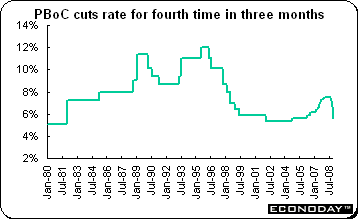 The People’s Bank of China (PboC) surprised the market on November 26th (effective November 27th) with a massive 108 basis point cut in its one-year lending rate to 5.58 percent following data that showed the economy slowing rather more quickly than expected. It was the largest rate cut in 11 years. The PBoC cut its lending rate one month ago by 27 basis points. In addition, the Bank decided to cut the reserve requirement ratio (RRR) for major deposit-taking institutions by another 100 basis points and the RRR for smaller institutions by 200 basis points. The central bank statement highlighted that the move was in line with the earlier announcement of an “appropriately easy” monetary policy stance, intended to ensure adequate liquidity in the banking system and stable monetary and credit conditions, and thus stable economic growth. The People’s Bank of China (PboC) surprised the market on November 26th (effective November 27th) with a massive 108 basis point cut in its one-year lending rate to 5.58 percent following data that showed the economy slowing rather more quickly than expected. It was the largest rate cut in 11 years. The PBoC cut its lending rate one month ago by 27 basis points. In addition, the Bank decided to cut the reserve requirement ratio (RRR) for major deposit-taking institutions by another 100 basis points and the RRR for smaller institutions by 200 basis points. The central bank statement highlighted that the move was in line with the earlier announcement of an “appropriately easy” monetary policy stance, intended to ensure adequate liquidity in the banking system and stable monetary and credit conditions, and thus stable economic growth.
Bank Indonesia
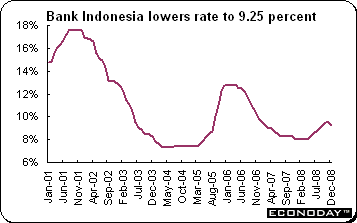 Bank Indonesia unexpectedly lowered interest rates for the first time in a year by 25 basis points to 9.25 percent. Indonesia joins other Asian central banks in reducing borrowing costs to help boost growth after the government cut its economic-expansion forecast for 2009 to a seven-year low of 4.5 percent. Bank Indonesia unexpectedly lowered interest rates for the first time in a year by 25 basis points to 9.25 percent. Indonesia joins other Asian central banks in reducing borrowing costs to help boost growth after the government cut its economic-expansion forecast for 2009 to a seven-year low of 4.5 percent.
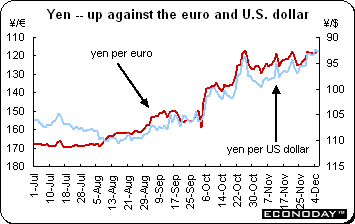 The yen and U.S. dollar continued to strengthen against most other major currencies such as the pound sterling and euro as the flight from risk continued and U.S. bonds remained the investment ‘du jour’. Even as U.S. employment contracted dramatically and the unemployment rate climbed, the dollar lost little ground. The report had no redeeming features. The euro had problems of its own after the important German orders data showed a larger than expected drop. The yen and U.S. dollar continued to strengthen against most other major currencies such as the pound sterling and euro as the flight from risk continued and U.S. bonds remained the investment ‘du jour’. Even as U.S. employment contracted dramatically and the unemployment rate climbed, the dollar lost little ground. The report had no redeeming features. The euro had problems of its own after the important German orders data showed a larger than expected drop.
The yen was up for a fifth week against the dollar, its longest rally since December 2004, as speculation that the Federal Reserve will cut borrowing costs to near zero this month rose to fever pitch. Like the yen, the dollar strengthened as investors sold higher-yielding assets and repatriated funds. Treasuries rallied as investors sought refuge in U.S. government debt, pushing yields to record lows. Three-month bill rates were at 0.01 percent for a third day.
The Canadian dollar continued to drop thanks to a combination of sinking crude oil prices and the political chaos that has resulted in Prime Minister Stephen Harper suspending Parliament to save his minority government. Commodities generate a third of Canada’s export revenue.
The pound sterling fell to a six-and-a-half-year low against the dollar Thursday and hit a record low against the euro before recovering ground after UK interest rates were cut to their lowest level since 1951.
The Chinese yuan dropped the most against the U.S. dollar since currency reforms were launched in July 2005 as investors continued to pile on bets that the government will allow for a sustained period of depreciation. The weakness began on Monday when People's Bank of China stunned the market by setting the central parity at 6.8505 renminbi to the U.S. dollar, the lowest fixing since August 21. The fixing occurred shortly after the purchasing managers’ index hit a record low indicating the manufacturing sector was contracting. The central bank eventually stepped in late Wednesday to sell dollars into the market to ease their burden.
Selected currencies — weekly results
|
|
2007 |
2008 |
% change |
|
|
Dec 31 |
Nov 28 |
Dec 5 |
Week |
Year |
| U.S. $ per currency |
|
|
|
|
|
|
| Australia |
A$ |
0.878 |
0.655 |
0.648 |
-1.0% |
-26.2% |
| New Zealand |
NZ$ |
0.774 |
0.550 |
0.535 |
-2.7% |
-30.9% |
| Canada |
C$ |
1.012 |
0.806 |
0.787 |
-2.4% |
-22.3% |
| Eurozone |
euro (€) |
1.460 |
1.270 |
1.272 |
0.1% |
-12.9% |
| UK |
pound sterling (£) |
1.984 |
1.540 |
1.474 |
-4.3% |
-25.7% |
|
|
|
|
|
|
|
| Currency per U.S. $ |
|
|
|
|
|
|
| China |
yuan |
7.295 |
6.844 |
6.848 |
-0.1% |
6.5% |
| Hong Kong |
HK$* |
7.798 |
7.750 |
7.755 |
-0.1% |
0.6% |
| India |
rupee |
39.410 |
50.100 |
49.575 |
1.1% |
-20.5% |
| Japan |
yen |
111.710 |
95.615 |
92.990 |
2.8% |
20.1% |
| Malaysia |
ringgit |
3.306 |
3.624 |
3.631 |
-0.2% |
-8.9% |
| Singapore |
Singapore $ |
1.436 |
1.513 |
1.522 |
-0.6% |
-5.7% |
| South Korea |
won |
935.800 |
1469.000 |
1479.350 |
-0.7% |
-36.7% |
| Taiwan |
Taiwan $ |
32.430 |
33.310 |
33.590 |
-0.8% |
-3.5% |
| Thailand |
baht |
29.500 |
35.470 |
35.695 |
-0.6% |
-17.4% |
| Switzerland |
Swiss franc |
1.133 |
1.214 |
1.222 |
-0.7% |
-7.3% |
|
|
|
|
|
|
|
| *Pegged to U.S. dollar |
|
|
|
|
|
|
| Source: Bloomberg |
|
|
|
|
|
|
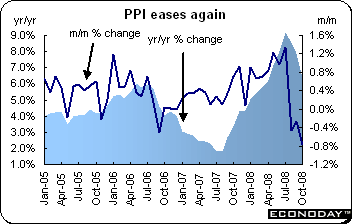 October producer prices excluding construction dropped 0.8 percent and were up 6.3 percent when compared with last year. Collapsing energy costs, down 2 percent on the month, were the primary driver of lower prices. Core PPI which excludes energy and food dropped 0.4 percent and was up 3.2 percent on the year. Apart from energy, intermediates were down 1.0 percent and nondurable consumer goods were down 0.1 percent. Capital goods were unchanged on the month while consumer durables rose 0.3 percent. October producer prices excluding construction dropped 0.8 percent and were up 6.3 percent when compared with last year. Collapsing energy costs, down 2 percent on the month, were the primary driver of lower prices. Core PPI which excludes energy and food dropped 0.4 percent and was up 3.2 percent on the year. Apart from energy, intermediates were down 1.0 percent and nondurable consumer goods were down 0.1 percent. Capital goods were unchanged on the month while consumer durables rose 0.3 percent.
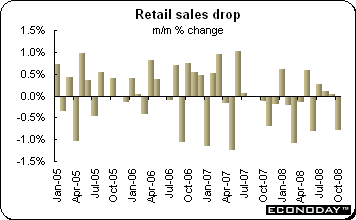 October retail sales dropped 0.8 percent and were down 2.3 percent when compared with last year. The monthly drop in purchases was split between the food and non-food sectors. Non-food sales dropped 0.9 percent and were down 2.2 percent on the year while food sales declined by 0.5 percent and were down 2.1 percent on the year. October retail sales dropped 0.8 percent and were down 2.3 percent when compared with last year. The monthly drop in purchases was split between the food and non-food sectors. Non-food sales dropped 0.9 percent and were down 2.2 percent on the year while food sales declined by 0.5 percent and were down 2.1 percent on the year.
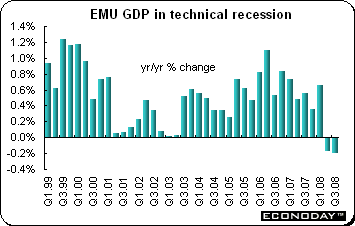 Third quarter gross domestic product dropped 0.2 percent for the second quarter and was up 0.6 percent when compared with the same quarter a year ago. The eurozone is now in a technical recession with two quarters of GDP contraction. Weakness was pervasive across components with consumer spending unchanged after contracting in the previous quarter while fixed capital formation sank 0.6 percent, compounding a 0.9 percent drop in the second quarter. Government consumption provided some stimulus with a second consecutive 0.8 percent gain and inventories added, in a potentially ominous reading, a large 0.3 percentage points to the bottom line. Exports were up 0.4 percent on the quarter but imports grew a much more rapid 1.7 percent to ensure a negative contribution of 0.5 percentage points from net foreign trade. Third quarter gross domestic product dropped 0.2 percent for the second quarter and was up 0.6 percent when compared with the same quarter a year ago. The eurozone is now in a technical recession with two quarters of GDP contraction. Weakness was pervasive across components with consumer spending unchanged after contracting in the previous quarter while fixed capital formation sank 0.6 percent, compounding a 0.9 percent drop in the second quarter. Government consumption provided some stimulus with a second consecutive 0.8 percent gain and inventories added, in a potentially ominous reading, a large 0.3 percentage points to the bottom line. Exports were up 0.4 percent on the quarter but imports grew a much more rapid 1.7 percent to ensure a negative contribution of 0.5 percentage points from net foreign trade.
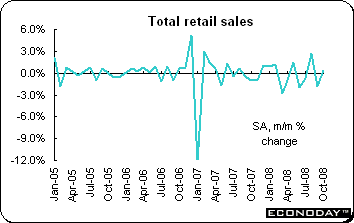 October total retail sales were up 0.4 percent but were down 1.7 percent when compared with last year. Excluding autos, sales were down 1.6 percent and dropped 1.4 percent on the year. By category, purchases fell especially heavily on the year in food & drink (2.8 percent) although non-food demand was down as well (0.6 percent). Within this latter sector, there were notable declines in pharmaceuticals & cosmetics (3.3 percent), mail order (3.3 percent), furniture & household goods (1.2 percent) and other goods (4.3 percent). The only areas to show higher sales from a year ago were clothing & shoes (0.5 percent) and other assorted goods (3.5 percent). October total retail sales were up 0.4 percent but were down 1.7 percent when compared with last year. Excluding autos, sales were down 1.6 percent and dropped 1.4 percent on the year. By category, purchases fell especially heavily on the year in food & drink (2.8 percent) although non-food demand was down as well (0.6 percent). Within this latter sector, there were notable declines in pharmaceuticals & cosmetics (3.3 percent), mail order (3.3 percent), furniture & household goods (1.2 percent) and other goods (4.3 percent). The only areas to show higher sales from a year ago were clothing & shoes (0.5 percent) and other assorted goods (3.5 percent).
 October manufacturers’ orders plummeted for the second month, dropping 6.1 percent after sinking 8.3 percent in September. Orders were down 17.3 percent when compared with last year. The latest monthly decline was evenly split between the domestic (6.1 percent) and overseas (6.2 percent) sectors. Within the former, there were declines across the board with basic goods down 7.1 percent, capital goods off 6.2 percent and consumer & durables 1.9 percent weaker. Foreign orders from other eurozone countries dropped 7.4 percent with basics down 4 percent, capital goods down 11.2 percent and consumer & durables down 1.2 percent. Non-eurozone orders dropped 5.2 percent with capital goods plummeting 9 percent and consumer & durable goods down 1.4 percent. October manufacturers’ orders plummeted for the second month, dropping 6.1 percent after sinking 8.3 percent in September. Orders were down 17.3 percent when compared with last year. The latest monthly decline was evenly split between the domestic (6.1 percent) and overseas (6.2 percent) sectors. Within the former, there were declines across the board with basic goods down 7.1 percent, capital goods off 6.2 percent and consumer & durables 1.9 percent weaker. Foreign orders from other eurozone countries dropped 7.4 percent with basics down 4 percent, capital goods down 11.2 percent and consumer & durables down 1.2 percent. Non-eurozone orders dropped 5.2 percent with capital goods plummeting 9 percent and consumer & durable goods down 1.4 percent.
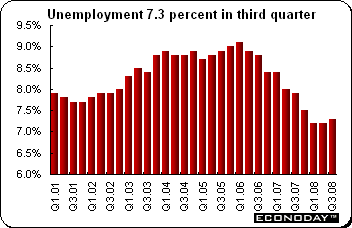 Third quarter jobless rate edged up to 7.3 percent from 7.2 percent in the second quarter. Including overseas territories, total unemployment also edged up a notch, from an upward revised 7.6 percent to 7.7 percent. The employment rate for mainland France once again held steady at 65.0 percent. The increase in the metropolitan jobless rate reflected a 9,000 rise in the number of unemployed over the second quarter to 2,035,000. Third quarter jobless rate edged up to 7.3 percent from 7.2 percent in the second quarter. Including overseas territories, total unemployment also edged up a notch, from an upward revised 7.6 percent to 7.7 percent. The employment rate for mainland France once again held steady at 65.0 percent. The increase in the metropolitan jobless rate reflected a 9,000 rise in the number of unemployed over the second quarter to 2,035,000.
 October retail sales were up 0.2 percent and 2.0 percent when compared with last year. Although overall sales were slightly better than anticipated the report is very lackluster. Food retailing was up 0.6 percent and other retailing was up 0.8 percent. Clothing & soft good retailing edged down 0.2 percent while household good retailing declined by 0.7 percent and cafes, restaurants & take out food services dropped by 0.6 percent. Sales at chains and other large retailers increased by 0.3 percent on the month and were up 5.0 percent on the year. October retail sales were up 0.2 percent and 2.0 percent when compared with last year. Although overall sales were slightly better than anticipated the report is very lackluster. Food retailing was up 0.6 percent and other retailing was up 0.8 percent. Clothing & soft good retailing edged down 0.2 percent while household good retailing declined by 0.7 percent and cafes, restaurants & take out food services dropped by 0.6 percent. Sales at chains and other large retailers increased by 0.3 percent on the month and were up 5.0 percent on the year.
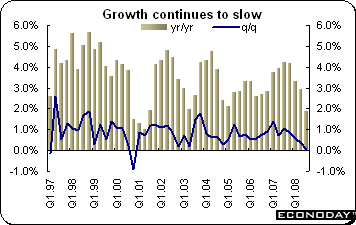 Third quarter gross domestic product edged up a slightly less than expected 0.1 percent on the quarter and was up 1.9 percent when compared with the same quarter a year ago. Final consumption expenditures edged up 0.2 percent and were up 2.2 percent on the year. Households were up 0.1 percent and 1.7 percent on the year. Gross fixed capital formation slowed to an increase of 0.8 percent on the quarter from 3.2 percent in the previous quarter. Total private business investment slowed to a gain of 1.5 percent from 4.7 percent in the second quarter while dwellings edged up 0.2 percent, down from the second quarter’s 1 percent gain. Third quarter gross domestic product edged up a slightly less than expected 0.1 percent on the quarter and was up 1.9 percent when compared with the same quarter a year ago. Final consumption expenditures edged up 0.2 percent and were up 2.2 percent on the year. Households were up 0.1 percent and 1.7 percent on the year. Gross fixed capital formation slowed to an increase of 0.8 percent on the quarter from 3.2 percent in the previous quarter. Total private business investment slowed to a gain of 1.5 percent from 4.7 percent in the second quarter while dwellings edged up 0.2 percent, down from the second quarter’s 1 percent gain.
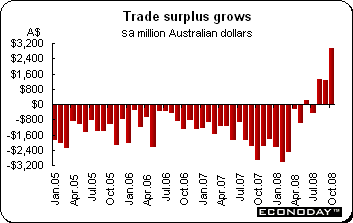 October merchandise trade surplus was A$2,952 million, an increase of A$1,698 million on a revised surplus in September 2008. The surplus was up primarily due to a 6.7 percent increase in exports while imports were edged up 0.3 percent. Non-rural exports were up 6 percent while rural goods exports jumped by 13 percent. Services exports were up a modest 1 percent. Imports were virtually unchanged on the month. Consumption goods imports were up 3 percent while intermediate and other merchandise goods edged up by 1 percent. Services imports were up 1 percent. Within the consumption goods component, textiles, clothing & footwear jumped by 12 percent while intermediate and other merchandise goods, driven by the fuels & lubricants component, were up 6 percent. October merchandise trade surplus was A$2,952 million, an increase of A$1,698 million on a revised surplus in September 2008. The surplus was up primarily due to a 6.7 percent increase in exports while imports were edged up 0.3 percent. Non-rural exports were up 6 percent while rural goods exports jumped by 13 percent. Services exports were up a modest 1 percent. Imports were virtually unchanged on the month. Consumption goods imports were up 3 percent while intermediate and other merchandise goods edged up by 1 percent. Services imports were up 1 percent. Within the consumption goods component, textiles, clothing & footwear jumped by 12 percent while intermediate and other merchandise goods, driven by the fuels & lubricants component, were up 6 percent.
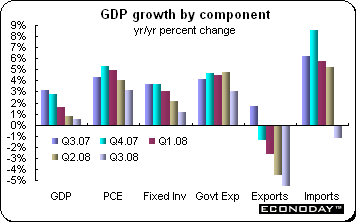 Third quarter gross domestic product was up 0.3 percent and was up 0.5 percent when compared with last year. The increase was driven mainly by inventories with only modest increases or declines among the other main expenditure components. Consumer spending crept up just 0.2 percent while government current expenditure rose only 0.1 percent. Both sides of the international trade balance contracted with exports down 1.4 percent and imports off an even steeper 1.6 percent. Final domestic demand decelerated to a mere 0.1 percent. By industry, goods producing output was up 0.5 percent with industrial production up 0.6 percent thanks to a 0.7 percent jump in energy. Manufacturing was up only 0.2 percent but this was still the first increase since the second quarter of 2007. Third quarter gross domestic product was up 0.3 percent and was up 0.5 percent when compared with last year. The increase was driven mainly by inventories with only modest increases or declines among the other main expenditure components. Consumer spending crept up just 0.2 percent while government current expenditure rose only 0.1 percent. Both sides of the international trade balance contracted with exports down 1.4 percent and imports off an even steeper 1.6 percent. Final domestic demand decelerated to a mere 0.1 percent. By industry, goods producing output was up 0.5 percent with industrial production up 0.6 percent thanks to a 0.7 percent jump in energy. Manufacturing was up only 0.2 percent but this was still the first increase since the second quarter of 2007.
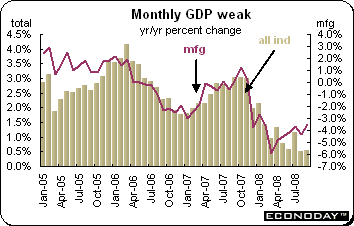 September monthly gross domestic product edged up 0.1 percent and was up 0.6 percent when compared with last year. Among the major production categories, the goods producing output was down 0.3 percent with industrial output declining 0.3 percent courtesy of a 0.9 percent drop in energy. Manufacturing production actually was up 0.3 percent. Service producing industries posted a 0.3 percent monthly gain with wholesale trade up an impressive 1.6 percent. September monthly gross domestic product edged up 0.1 percent and was up 0.6 percent when compared with last year. Among the major production categories, the goods producing output was down 0.3 percent with industrial output declining 0.3 percent courtesy of a 0.9 percent drop in energy. Manufacturing production actually was up 0.3 percent. Service producing industries posted a 0.3 percent monthly gain with wholesale trade up an impressive 1.6 percent.
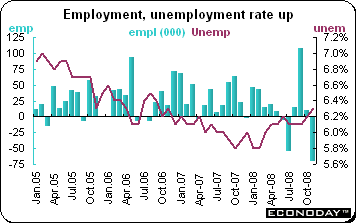 November employment declined by 70,600 jobs while at the same time, the unemployment rate edged up 0.1 percentage point to 6.3 percent. The employment decline was split between full-time (38,000) and part-time (38,000) jobs. Private sector payrolls were off 36,200. Employment in the goods producing sector dropped 32,800 within which manufacturing payrolls declined by 38,300 jobs. Agriculture also declined (10,100) but there were modest gains in natural resources (6,600), utilities (1,800) and construction (7,300). Employment in the service sector declined 37,300 and were dominated by a 26,700 drop in public administration, itself in large part a function of the unwinding the previous month’s temporary election hiring. However, there were also sizeable job losses in transportation & warehousing (26,000), educational services (15,600) and trade (8.900). The largest increase in payrolls in this sector was in health care & social assistance (17,700) followed by professional, scientific & technical services (16,300). The participation rate dropped 0.3 percentage points to 67.6 percent last month while the employment rate declined a more substantial 0.4 percentage points to 63.3 percent. Total unemployment stood at 1,162,000, up 22,300 from October. November employment declined by 70,600 jobs while at the same time, the unemployment rate edged up 0.1 percentage point to 6.3 percent. The employment decline was split between full-time (38,000) and part-time (38,000) jobs. Private sector payrolls were off 36,200. Employment in the goods producing sector dropped 32,800 within which manufacturing payrolls declined by 38,300 jobs. Agriculture also declined (10,100) but there were modest gains in natural resources (6,600), utilities (1,800) and construction (7,300). Employment in the service sector declined 37,300 and were dominated by a 26,700 drop in public administration, itself in large part a function of the unwinding the previous month’s temporary election hiring. However, there were also sizeable job losses in transportation & warehousing (26,000), educational services (15,600) and trade (8.900). The largest increase in payrolls in this sector was in health care & social assistance (17,700) followed by professional, scientific & technical services (16,300). The participation rate dropped 0.3 percentage points to 67.6 percent last month while the employment rate declined a more substantial 0.4 percentage points to 63.3 percent. Total unemployment stood at 1,162,000, up 22,300 from October.
Official interest rates plummeted as central banks took drastic rate cutting actions to stem the global recession. Employment tumbled in Canada and the United States. And other key economic data were abysmal, showing the steep drop in economic activity everywhere.
It is the Bank of Canada’s turn to cut rates this week. Analysts think that the nation's dire November employment report virtually guarantees a 50 basis point cut in the Bank of Canada rate next week to 1.75 percent. The employment loss was the biggest since June 1982. Elsewhere, new trade and industrial output data will dominate data releases. And Japan will release revised GDP data which is expected to show a greater contraction than the originally reported 0.1 percent quarterly decline.
| Central Bank activities |
|
| December 9 |
Canada |
Bank of Canada Announcement |
|
|
|
| The following indicators will be released this week... |
| Europe |
|
|
| December 8 |
Germany |
Industrial Production (October) |
|
UK |
Producer Input and Output Prices (November) |
| December 9 |
Germany |
Merchandise Trade Balance (October) |
|
|
ZEW Survey (December) |
|
UK |
Merchandise Trade Balance (October) |
|
|
Industrial Production (October) |
| December 10 |
France |
Industrial Production (October) |
|
Italy |
Industrial Production (October) |
|
|
Gross Domestic Product (Q3.2008 final) |
| December 12 |
EMU |
Industrial Production (October) |
|
|
|
| Asia/Pacific |
|
|
| December 9 |
Japan |
Gross Domestic Product (Q3.2008 revised) |
| December 10 |
Japan |
Corporate Goods Price Index (November) |
| December 11 |
Australia |
Employment, Unemployment (November) |
|
|
|
| Americas |
|
|
| December 11 |
Canada |
Merchandise Trade Balance (October) |
Anne D Picker is the author of International Economic Indicators and Central Banks.
|

![[Econoday]](images/econoday_logo_slim.gif)
![[Econoday]](images/logo.gif)


 Among the banks that lowered rates were the People’s Bank of China (108 basis points), Reserve Bank of Australia (100 basis points), Reserve Bank of New Zealand (150 basis points), Bank of England (100 basis points), Bank of Indonesia (25 basis points), Bank of Thailand (100 basis points), Sweden’s Riksbank (175 basis points) and the European Central Bank (75 basis points). Although the Bank of Japan held an ‘extraordinary’ — that is unscheduled — meeting, they left interest rates unchanged at 0.3 percent.
Among the banks that lowered rates were the People’s Bank of China (108 basis points), Reserve Bank of Australia (100 basis points), Reserve Bank of New Zealand (150 basis points), Bank of England (100 basis points), Bank of Indonesia (25 basis points), Bank of Thailand (100 basis points), Sweden’s Riksbank (175 basis points) and the European Central Bank (75 basis points). Although the Bank of Japan held an ‘extraordinary’ — that is unscheduled — meeting, they left interest rates unchanged at 0.3 percent.  While the gains in the last week of November were impressive for the three indexes followed here, they were quickly eroded in the first week of December. And on Thursday, European and UK stocks first rallied on the expectation of sizeable interest rate cuts by the Bank of England and the European Central Bank, then moved down after the cuts were announced. And economic data continue to show across the board declines in everything from retail sales and GDP to the purchasing managers’ indexes for manufacturing and services.
While the gains in the last week of November were impressive for the three indexes followed here, they were quickly eroded in the first week of December. And on Thursday, European and UK stocks first rallied on the expectation of sizeable interest rate cuts by the Bank of England and the European Central Bank, then moved down after the cuts were announced. And economic data continue to show across the board declines in everything from retail sales and GDP to the purchasing managers’ indexes for manufacturing and services.  The Bank of England cut its key interest rate by 100 basis points to 2.0 percent as expected though many in the markets were looking for even more. This cut follows the Bank’s surprise 150 basis point cut in November. Since September, the Bank has reduced rates by 3 full percentage points. This puts interest rates at the lowest level since 1951 and equals its lowest rate since the Bank was founded in 1694. It would also mark the steepest ever drop in rates. The last time the Bank of England cut interest rates by 1 percentage point to 2 percent was October 26 1939.
The Bank of England cut its key interest rate by 100 basis points to 2.0 percent as expected though many in the markets were looking for even more. This cut follows the Bank’s surprise 150 basis point cut in November. Since September, the Bank has reduced rates by 3 full percentage points. This puts interest rates at the lowest level since 1951 and equals its lowest rate since the Bank was founded in 1694. It would also mark the steepest ever drop in rates. The last time the Bank of England cut interest rates by 1 percentage point to 2 percent was October 26 1939. The ECB lowered its key interest rate by 75 basis points to 2.5 percent today. Analysts were expecting a 50 basis point cut but were hoping for more. The move was the largest that the Bank has made in its almost 10-year existence. Economic news continues to be dire and points to a deep recession. GDP has declined in the last two quarters and data such as the purchasing managers’ indexes showed both manufacturing and service sector output contracting. The ECB lowered its key interest rate by 50 basis points to 3.25 percent in November after lowering rates on October 8 by 50 basis points in concert with the Federal Reserve, Banks of England and Canada and other international central banks. The October rate cut was the first by the ECB in five years.
The ECB lowered its key interest rate by 75 basis points to 2.5 percent today. Analysts were expecting a 50 basis point cut but were hoping for more. The move was the largest that the Bank has made in its almost 10-year existence. Economic news continues to be dire and points to a deep recession. GDP has declined in the last two quarters and data such as the purchasing managers’ indexes showed both manufacturing and service sector output contracting. The ECB lowered its key interest rate by 50 basis points to 3.25 percent in November after lowering rates on October 8 by 50 basis points in concert with the Federal Reserve, Banks of England and Canada and other international central banks. The October rate cut was the first by the ECB in five years.  Most Asian/Pacific stock indexes reversed course last week, giving back most or all of the previous week’s advances. This was despite the numerous interest rate cuts that peppered the region. The lone exception was the Shanghai Composite — it was up last week, gaining 7.9 percent after losing 5 percent during the last week in November thanks to the People’s Bank of China’s massive interest rate cut effective on November 27. Investors hope that a meeting of top economic planners early next week will produce more government economic stimulus in addition to the package announced on November 9.
Most Asian/Pacific stock indexes reversed course last week, giving back most or all of the previous week’s advances. This was despite the numerous interest rate cuts that peppered the region. The lone exception was the Shanghai Composite — it was up last week, gaining 7.9 percent after losing 5 percent during the last week in November thanks to the People’s Bank of China’s massive interest rate cut effective on November 27. Investors hope that a meeting of top economic planners early next week will produce more government economic stimulus in addition to the package announced on November 9.  In addition to wariness about the employment report, Japanese investors were also cautious amid uncertainties over a prospective U.S. auto sector bailout proposal. The fate of the U.S. automakers is being closely monitored, as their survival is likely to affect the U.S. economy and the earnings of Japanese exporters that rely on the U.S. market.
In addition to wariness about the employment report, Japanese investors were also cautious amid uncertainties over a prospective U.S. auto sector bailout proposal. The fate of the U.S. automakers is being closely monitored, as their survival is likely to affect the U.S. economy and the earnings of Japanese exporters that rely on the U.S. market.  The Reserve Bank of Australia cut its policy interest rate by 100 basis points to 4.25 percent. It was the fourth rate reduction in as many months and the RBA’s most aggressive easing cycle since the early 1990s — the last time the country was in recession. The economy has been negatively affected by the global financial crisis and slower worldwide growth. House prices are falling and retail sales are anemic. The All Ordinaries has dropped more than 46 percent so far in 2008 and the Australian dollar has tumbled as investors fled risk and with that carry trades. The RBA with an inflation target range of 2 percent to 3 percent had been aggressively fighting inflation. The CPI was up 5 percent in the third quarter. The RBA increased interest rates 12 times between 2002 and March 2008 to 7.25 percent to reign in inflation. But the RBA recently amended its inflation forecast saying that inflation would peak in the fourth quarter of this year before declining into its target range in 2010. This is the last scheduled RBA meeting until February. The Bank is on summer holiday in January, but could schedule an emergency meeting should it be necessary.
The Reserve Bank of Australia cut its policy interest rate by 100 basis points to 4.25 percent. It was the fourth rate reduction in as many months and the RBA’s most aggressive easing cycle since the early 1990s — the last time the country was in recession. The economy has been negatively affected by the global financial crisis and slower worldwide growth. House prices are falling and retail sales are anemic. The All Ordinaries has dropped more than 46 percent so far in 2008 and the Australian dollar has tumbled as investors fled risk and with that carry trades. The RBA with an inflation target range of 2 percent to 3 percent had been aggressively fighting inflation. The CPI was up 5 percent in the third quarter. The RBA increased interest rates 12 times between 2002 and March 2008 to 7.25 percent to reign in inflation. But the RBA recently amended its inflation forecast saying that inflation would peak in the fourth quarter of this year before declining into its target range in 2010. This is the last scheduled RBA meeting until February. The Bank is on summer holiday in January, but could schedule an emergency meeting should it be necessary.  The People’s Bank of China (PboC) surprised the market on November 26th (effective November 27th) with a massive 108 basis point cut in its one-year lending rate to 5.58 percent following data that showed the economy slowing rather more quickly than expected. It was the largest rate cut in 11 years. The PBoC cut its lending rate one month ago by 27 basis points. In addition, the Bank decided to cut the reserve requirement ratio (RRR) for major deposit-taking institutions by another 100 basis points and the RRR for smaller institutions by 200 basis points. The central bank statement highlighted that the move was in line with the earlier announcement of an “appropriately easy” monetary policy stance, intended to ensure adequate liquidity in the banking system and stable monetary and credit conditions, and thus stable economic growth.
The People’s Bank of China (PboC) surprised the market on November 26th (effective November 27th) with a massive 108 basis point cut in its one-year lending rate to 5.58 percent following data that showed the economy slowing rather more quickly than expected. It was the largest rate cut in 11 years. The PBoC cut its lending rate one month ago by 27 basis points. In addition, the Bank decided to cut the reserve requirement ratio (RRR) for major deposit-taking institutions by another 100 basis points and the RRR for smaller institutions by 200 basis points. The central bank statement highlighted that the move was in line with the earlier announcement of an “appropriately easy” monetary policy stance, intended to ensure adequate liquidity in the banking system and stable monetary and credit conditions, and thus stable economic growth. Bank Indonesia unexpectedly lowered interest rates for the first time in a year by 25 basis points to 9.25 percent. Indonesia joins other Asian central banks in reducing borrowing costs to help boost growth after the government cut its economic-expansion forecast for 2009 to a seven-year low of 4.5 percent.
Bank Indonesia unexpectedly lowered interest rates for the first time in a year by 25 basis points to 9.25 percent. Indonesia joins other Asian central banks in reducing borrowing costs to help boost growth after the government cut its economic-expansion forecast for 2009 to a seven-year low of 4.5 percent.  The yen and U.S. dollar continued to strengthen against most other major currencies such as the pound sterling and euro as the flight from risk continued and U.S. bonds remained the investment ‘du jour’. Even as U.S. employment contracted dramatically and the unemployment rate climbed, the dollar lost little ground. The report had no redeeming features. The euro had problems of its own after the important German orders data showed a larger than expected drop.
The yen and U.S. dollar continued to strengthen against most other major currencies such as the pound sterling and euro as the flight from risk continued and U.S. bonds remained the investment ‘du jour’. Even as U.S. employment contracted dramatically and the unemployment rate climbed, the dollar lost little ground. The report had no redeeming features. The euro had problems of its own after the important German orders data showed a larger than expected drop.  October
October  October
October  Third quarter
Third quarter  October total
October total  October
October  Third quarter
Third quarter  October
October  Third quarter
Third quarter  October
October  Third quarter
Third quarter  September monthly
September monthly  November
November